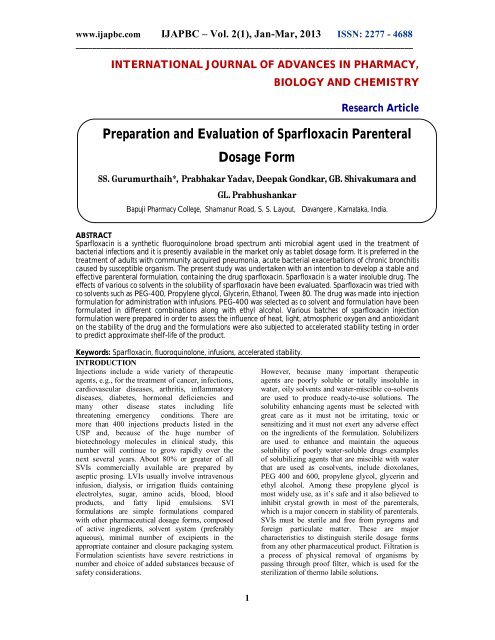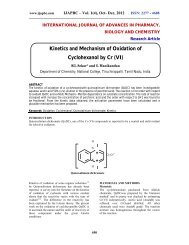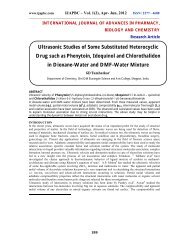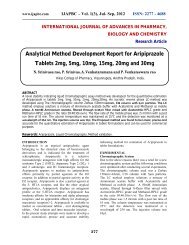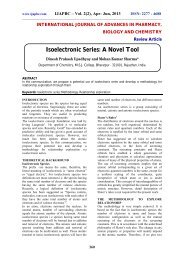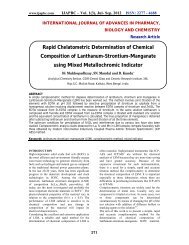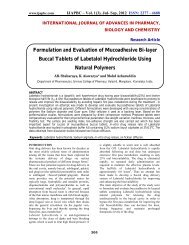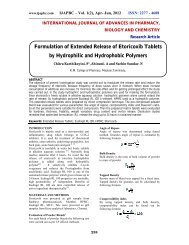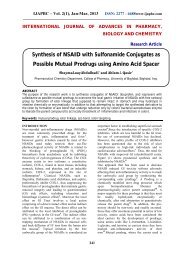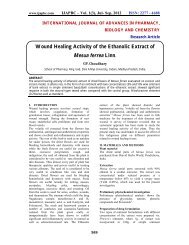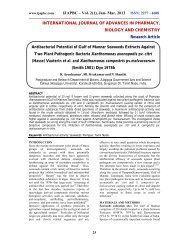Preparation and Evaluation of Sparfloxacin Parenteral ... - ijapbc
Preparation and Evaluation of Sparfloxacin Parenteral ... - ijapbc
Preparation and Evaluation of Sparfloxacin Parenteral ... - ijapbc
You also want an ePaper? Increase the reach of your titles
YUMPU automatically turns print PDFs into web optimized ePapers that Google loves.
www.<strong>ijapbc</strong>.com IJAPBC – Vol. 2(1), Jan-Mar, 2013 ISSN: 2277 - 4688<br />
_________________________________________________________________________________<br />
INTERNATIONAL JOURNAL OF ADVANCES IN PHARMACY,<br />
BIOLOGY AND CHEMISTRY<br />
Research Article<br />
<strong>Preparation</strong> <strong>and</strong> <strong>Evaluation</strong> <strong>of</strong> <strong>Sparfloxacin</strong> <strong>Parenteral</strong><br />
Dosage Form<br />
SS. Gurumurthaih*, Prabhakar Yadav, Deepak Gondkar, GB. Shivakumara <strong>and</strong><br />
GL. Prabhushankar<br />
Bapuji Pharmacy College, Shamanur Road, S. S. Layout, Davangere , Karnataka, India.<br />
ABSTRACT<br />
<strong>Sparfloxacin</strong> is a synthetic fluoroquinolone broad spectrum anti microbial agent used in the treatment <strong>of</strong><br />
bacterial infections <strong>and</strong> it is presently available in the market only as tablet dosage form. It is preferred in the<br />
treatment <strong>of</strong> adults with community acquired pneumonia, acute bacterial exacerbations <strong>of</strong> chronic bronchitis<br />
caused by susceptible organism. The present study was undertaken with an intention to develop a stable <strong>and</strong><br />
effective parenteral formulation, containing the drug sparfloxacin. <strong>Sparfloxacin</strong> is a water insoluble drug. The<br />
effects <strong>of</strong> various co solvents in the solubility <strong>of</strong> sparfloxacin have been evaluated. <strong>Sparfloxacin</strong> was tried with<br />
co solvents such as PEG-400, Propylene glycol, Glycerin, Ethanol, Tween 80. The drug was made into injection<br />
formulation for administration with infusions. PEG-400 was selected as co solvent <strong>and</strong> formulation have been<br />
formulated in different combinations along with ethyl alcohol. Various batches <strong>of</strong> sparfloxacin injection<br />
formulation were prepared in order to assess the influence <strong>of</strong> heat, light, atmospheric oxygen <strong>and</strong> antioxidant<br />
on the stability <strong>of</strong> the drug <strong>and</strong> the formulations were also subjected to accelerated stability testing in order<br />
to predict approximate shelf-life <strong>of</strong> the product.<br />
Keywords: <strong>Sparfloxacin</strong>, fluoroquinolone, infusions, accelerated stability.<br />
INTRODUCTION<br />
Injections include a wide variety <strong>of</strong> therapeutic<br />
agents, e.g., for the treatment <strong>of</strong> cancer, infections,<br />
cardiovascular diseases, arthritis, inflammatory<br />
diseases, diabetes, hormonal deficiencies <strong>and</strong><br />
many other disease states including life<br />
threatening emergency conditions. There are<br />
more than 400 injections products listed in the<br />
USP <strong>and</strong>, because <strong>of</strong> the huge number <strong>of</strong><br />
biotechnology molecules in clinical study, this<br />
number will continue to grow rapidly over the<br />
next several years. About 80% or greater <strong>of</strong> all<br />
SVIs commercially available are prepared by<br />
aseptic prosing. LVIs usually involve intravenous<br />
infusion, dialysis, or irrigation fluids containing<br />
electrolytes, sugar, amino acids, blood, blood<br />
products, <strong>and</strong> fatty lipid emulsions. SVI<br />
formulations are simple formulations compared<br />
with other pharmaceutical dosage forms, composed<br />
<strong>of</strong> active ingredients, solvent system (preferably<br />
aqueous), minimal number <strong>of</strong> excipients in the<br />
appropriate container <strong>and</strong> closure packaging system.<br />
Formulation scientists have severe restrictions in<br />
number <strong>and</strong> choice <strong>of</strong> added substances because <strong>of</strong><br />
safety considerations.<br />
However, because many important therapeutic<br />
agents are poorly soluble or totally insoluble in<br />
water, oily solvents <strong>and</strong> water-miscible co-solvents<br />
are used to produce ready-to-use solutions. The<br />
solubility enhancing agents must be selected with<br />
great care as it must not be irritating, toxic or<br />
sensitizing <strong>and</strong> it must not exert any adverse effect<br />
on the ingredients <strong>of</strong> the formulation. Solubilizers<br />
are used to enhance <strong>and</strong> maintain the aqueous<br />
solubility <strong>of</strong> poorly water-soluble drugs examples<br />
<strong>of</strong> solubilizing agents that are miscible with water<br />
that are used as cosolvents, include dioxolanes,<br />
PEG 400 <strong>and</strong> 600, propylene glycol, glycerin <strong>and</strong><br />
ethyl alcohol. Among these propylene glycol is<br />
most widely use, as it’s safe <strong>and</strong> it also believed to<br />
inhibit crystal growth in most <strong>of</strong> the parenterals,<br />
which is a major concern in stability <strong>of</strong> parenterals.<br />
SVIs must be sterile <strong>and</strong> free from pyrogens <strong>and</strong><br />
foreign particulate matter. These are major<br />
characteristics to distinguish sterile dosage forms<br />
from any other pharmaceutical product. Filtration is<br />
a process <strong>of</strong> physical removal <strong>of</strong> organisms by<br />
passing through pro<strong>of</strong> filter, which is used for the<br />
sterilization <strong>of</strong> thermo labile solutions.<br />
1
www.<strong>ijapbc</strong>.com IJAPBC – Vol. 2(1), Jan-Mar, 2013 ISSN: 2277 - 4688<br />
_________________________________________________________________________________<br />
Drugs with sufficient solution stability will still<br />
require certain formulation, packaging or storage<br />
conditions to maintain stability during shelf <strong>of</strong><br />
drugs in SVIs as they are generally unstable.<br />
<strong>Sparfloxacin</strong> is member <strong>of</strong> fluoroquinolone class <strong>of</strong><br />
antimicrobial drugs. It is active against a wide<br />
range <strong>of</strong> Gram + ve <strong>and</strong> Gram -ve organisms, with<br />
chemical name 5-amino-1-cyclopropyl-7-[(3S,5R)-<br />
3,5-dimethylpiperazin-1-yl]-6,8-difluoro-4-<br />
oxoquinoline-3-carboxylic acid <strong>and</strong> molecular<br />
formula C 19 H 22 F 2 N 4 O 3 . It is used in treatment <strong>of</strong><br />
urinary tract infection.<br />
MATERIALS AND METHODS<br />
List <strong>of</strong> ingredients used is given in Table 1.<br />
Preformulation Studies 2,3,4,5,6<br />
Solubility studies <strong>of</strong> <strong>Sparfloxacin</strong> in different<br />
solvents (saturation solubility method)<br />
Excess <strong>of</strong> drug was added to different solvents in<br />
10 ml stoppered volumetric flasks. Then Drug was<br />
made to dissolve in the solvent by placing the<br />
volumetric flask in the shaker bath at 25° C for 6<br />
hours. The volumetric flasks were then placed at<br />
room temperature for 24 hours. The solutions were<br />
filtered <strong>and</strong> appropriate dilutions were made to<br />
measure absorbances at 286nm using UV visible<br />
spectrophotometer, <strong>and</strong> water as blank. The data<br />
are given in Table 3.<br />
Effect <strong>of</strong> Temperature on Stability <strong>of</strong> Drug<br />
1% <strong>Sparfloxacin</strong> solution in 0.0.1N NaOH is filled<br />
into vials. The vials were sealed <strong>and</strong> placed at<br />
refrigeration, room-temperature, 50°C, 75°C <strong>and</strong><br />
95°C for 1 week <strong>and</strong> observed for colour change<br />
<strong>and</strong> crystal growth. The samples placed at<br />
refrigeration <strong>and</strong> room temperature served as<br />
controls. The data are given in Table 4.<br />
Light Stability <strong>of</strong> Drug<br />
1% <strong>of</strong> <strong>Sparfloxacin</strong> solution in 0.0.1N NaOH is<br />
filled in to 20ml glass vials (amber <strong>and</strong> clear).<br />
Also samples <strong>of</strong> drug substance are placed in an<br />
open perti dish to expose a large surface. Drug <strong>and</strong><br />
dilutions placed in a light-resistant amber coloured<br />
glass vials, foil wrapped <strong>and</strong> in a cardboard box as<br />
controls. This is carried out for 4 weeks with<br />
weekly examinations for visible colour change or<br />
precipitation in solution in clear vials, the<br />
compound can be considered as potentially light<br />
sensitive <strong>and</strong> should be h<strong>and</strong>led accordingly. The<br />
data are given in Table 5.<br />
Effect <strong>of</strong> Oxygen on Drug<br />
1% <strong>of</strong> <strong>Sparfloxacin</strong> in 0.0.1N NaOH is filled into<br />
vials <strong>and</strong> placed at 30°C <strong>and</strong> 40°C. One group is<br />
purged <strong>and</strong> another group is sealed with air.<br />
Solutions are observed for colour change <strong>and</strong> drug<br />
content. The data are given in Table 6 to 11.<br />
FORMULATION DEVELOPMENT<br />
Attempts were made to develop a stable parenteral<br />
formulation using cosolvent/s along with other<br />
excipients. The dose selected for formulation was<br />
400 mg <strong>of</strong> <strong>Sparfloxacin</strong> in 2ml solvent. The<br />
prepared formulations contain the following<br />
ingredients along with their concentrations are<br />
given in Table 2.<br />
Thus prepared formulations were assayed for drug<br />
content respectively <strong>and</strong> 10ml <strong>of</strong> these were placed<br />
at 5°C, room temperature (RT), 37°C, 40°C <strong>and</strong><br />
45°C for six weeks <strong>and</strong> observed for crystal<br />
growth, clarity, pH change, <strong>and</strong> drug content.<br />
POST FORMULATION EVALUATIONS<br />
Assay <strong>of</strong> Formulations<br />
Reference Solution <strong>Preparation</strong><br />
100ml <strong>of</strong> stock reference solutions for each<br />
formulation was prepared. The composition <strong>of</strong> the<br />
reference stock solution was similar to that <strong>of</strong> the<br />
respective formulations excluding the drug <strong>and</strong> also<br />
they were diluted similarly as the formulations<br />
were diluted using water. This resulting solution is<br />
used as reference solution (blank) in comparison<br />
with the prepared formulations to measure the %<br />
drug content by measuring the absorbencies using<br />
Shimadzu UV-Visible spectrophotometer. The<br />
amount <strong>of</strong> <strong>Sparfloxacin</strong> was determined from<br />
st<strong>and</strong>ard calibration curve. The data are given in<br />
Table 12.<br />
Sterilization Studies<br />
The injection samples were taken in glass syringe,<br />
the membrane filter holder was attached to the<br />
syringe. A prefilter <strong>of</strong> 1.5 micrometers was placed<br />
in this holder, after which filters <strong>of</strong> 0.22, 0.45, 1.2<br />
<strong>and</strong> 1.5 micrometers were placed successively <strong>and</strong><br />
tested whether the injection sample could pass<br />
through these membrane or not. The data are given<br />
in Table 13.<br />
STERILITY TESTING<br />
Direct Transfer Method<br />
Aliquots <strong>of</strong> the samples are transferred aseptically<br />
into fluid thioglycolate medium <strong>and</strong> soybean casein<br />
digest medium. The inoculated thioglycolate<br />
medium is incubated at 32 ° C <strong>and</strong> soybean casein<br />
digest samples at 22 ° C for 7 days. Likewise<br />
negative <strong>and</strong> positive controls are prepared. The<br />
data are given in Table 14.<br />
STABILITY STUDIES<br />
For any pharmaceutical dosage form stability <strong>of</strong> the<br />
prepared formulation is a very basic <strong>and</strong> important<br />
factor, from point <strong>of</strong> view <strong>of</strong> safety <strong>of</strong> the patient<br />
being treated with <strong>and</strong> to get a safe <strong>and</strong> maximum<br />
therapeutic response <strong>of</strong> the drug.<br />
The provision <strong>of</strong> rapid means <strong>of</strong> quality control,<br />
which ensures that no unexpected changes in the<br />
2
www.<strong>ijapbc</strong>.com IJAPBC – Vol. 2(1), Jan-Mar, 2013 ISSN: 2277 - 4688<br />
_________________________________________________________________________________<br />
stored product are occurred like: Crystal growth,<br />
pH changes, Clarity <strong>and</strong> % Drug content.<br />
Crystal Growth<br />
10 ml <strong>of</strong> the each prepared formulations F5 <strong>and</strong> F6<br />
were placed at refrigeration, room temperature,<br />
37°C, 40°C <strong>and</strong> 45°C respectively for six weeks<br />
<strong>and</strong> observed for crystal growth. The data are given<br />
in Table 15.<br />
pH Changes<br />
10 ml <strong>of</strong> the each prepared formulations F5 <strong>and</strong> F6<br />
were kept at different temperatures/conditions such<br />
as refrigeration, room temperature, 37 ° C, 40 ° C,<br />
45 ° C <strong>and</strong> under light. At regular time intervals the<br />
samples were examined for pH changes for six<br />
weeks using a digital pH meter. The data are given<br />
in Table 16.<br />
Clarity<br />
10 ml <strong>of</strong> the formulations were placed at<br />
refrigeration, room temperature, 37°C, 40°C <strong>and</strong><br />
45°C for six weeks <strong>and</strong> observed for colour change<br />
or turbidity. The data are given in Table 17.<br />
% Drug Content<br />
The drug content <strong>of</strong> the formulations F5 <strong>and</strong> F6<br />
were determined by following the same procedures<br />
as mentioned in assay. The estimates were done at<br />
intervals <strong>of</strong> one week upto six weeks. The data are<br />
given in Table 18 to 21.<br />
.<br />
Compatibility <strong>of</strong> rubber closures with F5 <strong>and</strong> F6<br />
The formulation was filled in 10 ml glass vials <strong>and</strong><br />
stoppered with west gray butyl rubber stoppers.<br />
Vials were also stoppered with west gray Tefloncoated<br />
stoppers <strong>and</strong> served as controls. The vials<br />
were placed upright <strong>and</strong> inverted in the stability<br />
chambers maintained at 40°C with 75% RH, 25°C<br />
with 60% RH, <strong>and</strong> refrigeration. The vials were<br />
inverted to obtain maximum exposure <strong>of</strong> the rubber<br />
closure to the formulation for four weeks <strong>and</strong> the<br />
contents <strong>of</strong> the vials were periodically analyzed for<br />
drug content. The data are given in Table 22.<br />
Effect <strong>of</strong> silastic tubing on F5 <strong>and</strong> F6<br />
The effect <strong>of</strong> silastic tubing on formulation was<br />
tested by immersing the tubing in the formulations<br />
F5 <strong>and</strong> F6 for 24 hours at room temperature. The<br />
tubing was also immersed in the formulation<br />
vehicle for the same period <strong>of</strong> time <strong>and</strong> this served<br />
as a control. Then all solutions were analyzed by<br />
UV spectrophotometric method to determine any<br />
loss <strong>of</strong> drug via adsorption. The data are given in<br />
Table 25.<br />
Dilution study 7,8,9,10<br />
Precipitation <strong>of</strong> drug <strong>of</strong>ten occurs upon injecting<br />
a formulation into body fluids. The amount <strong>of</strong><br />
precipitation can be correlated with the rate at which the<br />
drug is injected. Method for determination <strong>of</strong> such<br />
effect is dilution study.<br />
The serial dilutions <strong>of</strong> formulations were prepared<br />
in ratio <strong>of</strong> 20:50 to 20:500 <strong>and</strong> stored at room<br />
temperature <strong>and</strong> examined visually for the<br />
appearance <strong>of</strong> crystals <strong>and</strong> turbidity upto 24 hours.<br />
The data are given in Table 26 to 29.<br />
Shelf Life Determination 11,12,13,14<br />
The injections stored at 37 ºC, 40ºC, 45ºC <strong>and</strong> light<br />
were subjected to the shelf life determination<br />
studies<br />
Prediction <strong>of</strong> Shelf Life<br />
The log percentage drug retained (undecomposed)<br />
values <strong>of</strong> the four formulations F5 <strong>and</strong> F6 stored at<br />
37 ºC, 40 ºC <strong>and</strong> 45 ºC are given in Table 30 <strong>and</strong><br />
are graphically represented in Figure 3 to 6. The<br />
results obtained <strong>of</strong> the above graphs using<br />
Arrhenius plot shelf life <strong>of</strong> the all four formulations<br />
were predicted.<br />
RESULTS AND DISCUSSION<br />
Table 3: Solubility pr<strong>of</strong>ile <strong>of</strong> <strong>Sparfloxacin</strong> in different solvents<br />
Sl.<br />
Absorbances* at<br />
St<strong>and</strong>ard<br />
Solvents<br />
Dilution<br />
Concentration mg/ml<br />
No<br />
291.5nm<br />
deviation<br />
1 DM Water 10 0.7796 0.1055 ± 0.108<br />
2 0.1N NaOH 10000 0.283667 38.41986 ± 0.021<br />
3 0.1N HCl 50 0.134667 0.091196 ± 0.003<br />
4 5% PEG 50 0.21 0.142212 ± 0.026<br />
5 10% PEG 50 0.97933 0.663205 ± 0.009<br />
6 5% Propylene glycol 50 0.42 0.284424 ± 0.006<br />
7 10% Propylene glycol 100 0.11933 0.161625 ± 0.008<br />
8 20% Propylene glycol 100 0.162 0.219413 ± 0.006<br />
9 10% Glycerine 100 0.12133 0.164334 ± 0.007<br />
10 20% Glycerine 100 0.13433 0.181941 ± 0.003<br />
11 Ethanol 100 0.7623 1.03246 ± 0.010<br />
12 Tween 80 100 0.4186 0.56704 ± 0.003<br />
3
www.<strong>ijapbc</strong>.com IJAPBC – Vol. 2(1), Jan-Mar, 2013 ISSN: 2277 - 4688<br />
_________________________________________________________________________________<br />
STABILITY EVALUATION<br />
Various stress tests are performed on solid <strong>and</strong><br />
solution samples to establish the effect <strong>of</strong> heat,<br />
light <strong>and</strong> oxygen on the drug substance stability.<br />
1. Heat stability<br />
2. Light stability<br />
3. Effect <strong>of</strong> oxygen<br />
Table 4: Heat stability pr<strong>of</strong>ile<br />
<strong>of</strong> sparfloxacin<br />
Temperature<br />
(°C)<br />
Duration (weeks)<br />
1 2 3 4<br />
Refrigeration - - - -<br />
Room temperature - - - -<br />
40 - - - -<br />
50 + + + +<br />
75 + + + +<br />
+ Colour change, - No colour change<br />
Table 5: Light stability study <strong>of</strong> sparfloxacin<br />
Withdrawal week Observation<br />
1 -<br />
2 -<br />
3 -<br />
4 -<br />
- Clear, + Turbidity<br />
4. Estimation <strong>of</strong> drug content<br />
Table 6: Test for colour change after a week<br />
Temperature(°C) Air sealed vials Perged vials<br />
30 + -<br />
40 + +<br />
+ colour change, - no colour change<br />
Table 7: Drug content in freshly prepared drug solution<br />
Absorbance at<br />
291.5nm<br />
Concentration<br />
in µg/ml<br />
Concentration in<br />
mg/ml<br />
0.703 9844.21 9.8442<br />
Table 8: Drug content in perged vials at 30°C<br />
Absorbance at<br />
291.5nm<br />
Concentration in<br />
µg/ml<br />
Concentration in<br />
mg/ml<br />
0.701 9816.20 9.8162<br />
Table 9: Drug content in air sealed vials at 30°C<br />
Absorbance at<br />
291.5nm<br />
Concentration in<br />
µg/ml<br />
Concentration<br />
in mg/ml<br />
0.612 8569.92 8.5699<br />
None <strong>of</strong> the above solutions were found to be sensitive to oxygen.<br />
4
www.<strong>ijapbc</strong>.com IJAPBC – Vol. 2(1), Jan-Mar, 2013 ISSN: 2277 - 4688<br />
_________________________________________________________________________________<br />
FORMULATION DEVELOPMENT<br />
A stable parenteral formulation <strong>of</strong> slightly water<br />
soluble drug <strong>Sparfloxacin</strong> was formulated after<br />
performing trials with various solvents. Thus<br />
prepared formulations were subjected for various<br />
tests <strong>and</strong> results are discussed in the following<br />
section.<br />
Formulation<br />
Table 10: Percentage Drug content <strong>of</strong> various<br />
formulation trials containing <strong>Sparfloxacin</strong><br />
Absorbance* at<br />
286nm<br />
Drug content<br />
(mg/ml)<br />
% Drug<br />
content<br />
St<strong>and</strong>ard<br />
deviation<br />
F1 0.8343 204.6746 102.3373 ± 0.0015<br />
F2 0.8273 202.3574 101.4787 ± 0.0020<br />
F3 0.8430 206.8007 103.4003 ± 0.0026<br />
F4 0.8345 204.7589 102.1564 ± 0.0010<br />
F5 0.8337 204.511 102.2555 ± 0.0023<br />
* Each value is an average <strong>of</strong> three determinations<br />
Table 11: Filter pore size <strong>and</strong> filterability<br />
<strong>of</strong> the formulations <strong>of</strong> <strong>Sparfloxacin</strong><br />
Formulation Filter pore size(µm) Observation<br />
0.22 +<br />
F1<br />
0.45 +<br />
1.2 +<br />
1.5 +<br />
0.22 +<br />
F2<br />
0.45 +<br />
1.2 +<br />
F3<br />
F4<br />
F5<br />
1.5 +<br />
0.22 +<br />
0.45 +<br />
1.2 +<br />
1.5 +<br />
0.22 +<br />
0.45 +<br />
1.2 +<br />
1.5 +<br />
0.22 +<br />
0.45 +<br />
1.2 +<br />
1.5 +<br />
+ Injection passes through. - Injection does not pass through<br />
All the formulations were found to be easily<br />
passing through all the pore size filters <strong>and</strong> hence<br />
0.22 µm pore size filter was selected to filter all the<br />
prepared formulations separately.<br />
None <strong>of</strong> the formulations showed turbidity or signs<br />
<strong>of</strong> microbial growth (except the positive control) at<br />
the end <strong>of</strong> incubation period, indicating all the<br />
formulations were sterile <strong>and</strong> thus all the<br />
formulations are subjected to further evaluations.<br />
POST FORMULATION STUDIES<br />
Effect <strong>of</strong> different temperature on crystal growth<br />
Table 12: Effect <strong>of</strong> different<br />
temperature on crystal growth<br />
Formulation RT 40°C 50°C<br />
F1 + + +<br />
F2 + - -<br />
F3 - - -<br />
F4 + + -<br />
F5 - - -<br />
F6 - - -<br />
+ Crystal growth, - No crystal growth<br />
5
www.<strong>ijapbc</strong>.com IJAPBC – Vol. 2(1), Jan-Mar, 2013 ISSN: 2277 - 4688<br />
_________________________________________________________________________________<br />
In the formulations F3, F5 <strong>and</strong> F6 no crystals were<br />
developed after two weeks. So F3, F5 <strong>and</strong> F6 are<br />
stable at temperatures studied.<br />
Effect <strong>of</strong> different temperature on clarity<br />
Table 13: Effect <strong>of</strong> different temperature on clarity<br />
Formulation RT 40°C 50°C<br />
F1 + + +<br />
F2 + + +<br />
F3 - - -<br />
F4 - + +<br />
F5 - - -<br />
F6 - - -<br />
+ Turbid, - Clear<br />
F3, F5 <strong>and</strong> F6 are clear after two weeks. So F3, F5 <strong>and</strong> F6 are stable at temperatures studied.<br />
Effect <strong>of</strong> different temperature on colour change<br />
+colour change, - no colour change.<br />
Table 14: Effect <strong>of</strong> different temperature<br />
on colour change<br />
Formulation 5°C RT 40°C 50°C<br />
F1 - - + +<br />
F2 - - + +<br />
F3 - - + +<br />
F4 - - + +<br />
F5 - - - +<br />
F6 - - - +<br />
F5 <strong>and</strong> F6 shows no colour change up to 40°C but at 50°C colour change was observed. So F5 <strong>and</strong> F6 are stable<br />
at temperatures studied.<br />
SCALE UP STUDIES<br />
ASSAY OF THE FORMULATIONS<br />
Table 15: Drug content <strong>of</strong> F5 <strong>and</strong> F6<br />
Formulation<br />
Absorbance* at<br />
291.5nm<br />
Drug<br />
content<br />
(mg/ml)<br />
% Drug<br />
content<br />
St<strong>and</strong>ard<br />
deviation<br />
F5 0.7616 20.632 103.160 ±0.0006<br />
F6 0.7586 20.550 102.754 ±0.0006<br />
* Each value is an average <strong>of</strong> three determinations<br />
STERILIZATION STUDIES AND STERILITY TESTING<br />
FILTRATION<br />
Table 16: Filter pore size <strong>and</strong> filterability <strong>of</strong> the formulations <strong>of</strong> sparfloxacin<br />
Sl. No Formulation<br />
Filter pore size<br />
(µm)<br />
Observation<br />
0.22 +<br />
1 F5<br />
0.45 +<br />
1.2 +<br />
1.5 +<br />
0.22 +<br />
2 F6<br />
0.45 +<br />
1.2 +<br />
1.5 +<br />
+ Injection passes through. - Injection does not pass through.<br />
6
www.<strong>ijapbc</strong>.com IJAPBC – Vol. 2(1), Jan-Mar, 2013 ISSN: 2277 - 4688<br />
_________________________________________________________________________________<br />
The results <strong>of</strong> filterability show that both the<br />
formulations <strong>of</strong> sparfloxacin passes through all the<br />
four membrane filters. Hence they can be sterilized<br />
by filteration.<br />
DIRECT TRANSFER METHOD<br />
Table 17: The growth <strong>of</strong> bacteria in soya bean casein digest medium <strong>and</strong> fluid<br />
thioglycollate medium after seven days<br />
Both the formulations pass the sterility test.<br />
Formulation Soyabean-casein digest<br />
medium (SCDM)<br />
Fluid thioglycollate<br />
medium (FTM)<br />
F5 - -<br />
F6 - -<br />
- Clear; + Turbid<br />
ACCELERATED STABILITY STUDIES<br />
pH CHANGES<br />
Table 18: pH changes <strong>of</strong> formulation F5 <strong>and</strong> F6 at<br />
different temperatures/conditions on ageing<br />
Formulation<br />
F5<br />
F6<br />
Withdrawal<br />
Week<br />
37°C 40°C 45°C Light<br />
0 10.13 10.13 10.13 10.13<br />
1 10.22 10.16 10.12 10.19<br />
2 10.21 10.16 10.15 10.23<br />
3 10.18 10.12 10.21 10.25<br />
4 10.17 10.17 10.25 10.26<br />
5 10.23 10.24 10.28 10.28<br />
6 10.26 10.21 10.39 10.34<br />
0 10.17 10.17 10.17 10.17<br />
1 10.20 10.21 10.31 10.17<br />
2 10.20 10.26 10.32 10.19<br />
3 10.21 10.26 10.42 10.22<br />
4 10.26 10.35 10.43 10.23<br />
5 10.28 10.39 10.51 10.28<br />
6 10.32 10.38 10.55 10.32<br />
CRYSTAL GROWTH<br />
Table 19: Crystal growth <strong>of</strong> formulation F5 <strong>and</strong> F6 at<br />
different temperatures/conditions on ageing<br />
Formulation<br />
F5<br />
F6<br />
Withdrawal<br />
Week<br />
37°C 40°C 45°C Light<br />
0 - - - -<br />
1 - - - -<br />
2 - - - -<br />
3 - - - -<br />
4 - - - -<br />
5 - - - -<br />
6 - - - -<br />
0 - - - -<br />
1 - - - -<br />
2 - - - -<br />
3 - - - -<br />
4 - - - -<br />
5 - - - -<br />
6 - - - -<br />
+crystal growth, - no crystal growth<br />
No crystal growth was observed in the formulations at different temperatures/conditions.<br />
7
www.<strong>ijapbc</strong>.com IJAPBC – Vol. 2(1), Jan-Mar, 2013 ISSN: 2277 - 4688<br />
_________________________________________________________________________________<br />
CLARITY STUDIES<br />
Table 20: Clarity <strong>of</strong> formulation F5 <strong>and</strong> F6<br />
at different temperatures/conditions on ageing<br />
Formulation<br />
Withdrawal<br />
Week<br />
37°C 40°C 45°C Light<br />
0 - - - -<br />
1 - - - -<br />
2 - - - -<br />
F5<br />
3 - - - -<br />
4 - - - -<br />
5 - - - -<br />
6 - - - -<br />
0 - - - -<br />
1 - - - -<br />
2 - - - -<br />
F6<br />
3 - - - -<br />
4 - - - -<br />
5 - - - -<br />
6 - - - -<br />
+ turbid, - clear<br />
All the formulations were clear at different temperatures/ conditions.<br />
DRUG CONTENT<br />
Table 21: Percent drug content <strong>of</strong> formulation F5<br />
at different temperatures/conditions on<br />
ageing<br />
Sample withdrawal<br />
(week)<br />
% Drug Content<br />
37°C 40°C 45°C Light<br />
0 103.1603 103.1603 103.1603 103.1603<br />
1 102.9345 102.8894 102.9345 103.1151<br />
2 102.8894 102.7991 102.5282 103.2054<br />
3 102.8445 102.3476 102.3476 103.0248<br />
4 102.7088 101.7607 101.9413 102.9345<br />
5 101.6253 101.535 99.5936 102.5734<br />
6 101.3544 101.3093 99.1873 102.3928<br />
Table 22: Percent drug content <strong>of</strong> formulation F6<br />
at different temperatures/conditions on<br />
ageing<br />
Sample withdrawal<br />
(week)<br />
% Drug Content<br />
37°C 40°C 45°C Light<br />
0 102.754 102.754 102.754 102.754<br />
1 102.212 102.212 100.451 102.979<br />
2 101.219 101.670 99.909 102.618<br />
3 100.812 100.722 99.774 102.121<br />
4 100.541 100.722 99.638 101.128<br />
5 100.180 100.406 99.187 101.038<br />
6 99.819 99.729 98.614 100.451<br />
COMPATIBILITY OF RUBBER CLOSURES WITH F5 AND F6<br />
Table 23: Compatibility <strong>of</strong> F5 with rubber closures<br />
Withdrawal week<br />
% Drug content<br />
5°C 25°C 40°C<br />
0 103.1603 103.1603 103.1603<br />
1 103.1603 103.1603 103.0248<br />
2 103.0248 103.07 102.7991<br />
3 103.0248 102.754 102.3476<br />
4 102.9345 102.6185 101.7156<br />
8
www.<strong>ijapbc</strong>.com IJAPBC – Vol. 2(1), Jan-Mar, 2013 ISSN: 2277 - 4688<br />
_________________________________________________________________________________<br />
Table 24: Compatibility <strong>of</strong> F6 with rubber closures<br />
Withdrawal week<br />
% Drug content<br />
5°C 25°C 40°C<br />
0 102.754 102.754 102.754<br />
1 102.6185 102.6637 102.0316<br />
2 102.5282 102.167 101.5801<br />
3 101.9413 101.7607 100.8578<br />
4 101.8962 101.3995 100.7223<br />
EFFECT OF SILASTIC TUBING ON F5 AND<br />
F6<br />
Silastic tubing is generally used to transfer the<br />
product from one container to another <strong>and</strong> for vial<br />
filling operations. Drug adsorption into these<br />
tubing materials may result in substantial loss <strong>of</strong><br />
potency. The recovery <strong>of</strong> sparfloxacin from<br />
formulations that had been in contact with silastic<br />
tubing for 24 hours was 100%, indicating no loss <strong>of</strong><br />
drug via absorption into the tubing. The nature <strong>of</strong><br />
solvents may affect the ability <strong>of</strong> the tubing to<br />
dispense the solution uniformly during the filling<br />
operation.<br />
DILUTION STUDY<br />
Table 25: Dilution study <strong>of</strong> F5<br />
Time (hours)<br />
Dilution<br />
Normal saline 5% w/v Dextrose solution<br />
(v/v)<br />
0 2 4 8 24 0 2 4 8 24<br />
20:50 - - - - - - - - - -<br />
20:100 - - - - - - - - - -<br />
20:200 - - - - - - - - - -<br />
20:300 - - - - - - - - - -<br />
20:400 - - - - - - - - - -<br />
20:500 - - - - - - - - - -<br />
+ Crystals, - Clear<br />
Table 26: Dilution study <strong>of</strong> F6<br />
Time (hours)<br />
Dilution<br />
Normal saline 5% w/v Dextrose solution<br />
(v/v)<br />
0 2 4 8 24 0 2 4 8 24<br />
20:50 - - - - - - - - - -<br />
20:100 - - - - - - - - - -<br />
20:200 - - - - - - - - - -<br />
20:300 - - - - - - - - - -<br />
20:400 - - - - - - - - - -<br />
20:500 - - - - - - - - - -<br />
+ Crystals, - Clear<br />
PREDICTION OF SHELF LIFE<br />
The log percentage drug retained (undecomposed) values <strong>of</strong> the formulations F5 <strong>and</strong> F6 are shown below.<br />
Table 27: Percentage drug retained (log values) <strong>of</strong> the formulations F5 <strong>and</strong> F6 stored at different<br />
temperatures on ageing<br />
Formulations<br />
F5<br />
Temperature<br />
Withdrawal week v/s log % drug content<br />
conditions 0 1 2 3 4 5 6<br />
37°C 2.0000 1.9990 1.9988 1.9987 1.9981 1.9935 1.9923<br />
40°C 2.0000 1.9988 1.9985 1.9966 1.9941 1.9931 1.9921<br />
45°C 2.0000 1.9990 1.9973 1.9966 1.9948 1.9847 1.9829<br />
Light 2.0000 1.9998 1.9998 1.9994 1.9990 1.9975 1.9967<br />
9
www.<strong>ijapbc</strong>.com IJAPBC – Vol. 2(1), Jan-Mar, 2013 ISSN: 2277 - 4688<br />
_________________________________________________________________________________<br />
F6<br />
37°C 2.0000 1.9977 1.9935 1.9917 1.9906 1.9890 1.9874<br />
40°C 2.0000 1.9977 1.9954 1.9913 1.9913 1.9900 1.9870<br />
45°C 2.0000 1.9902 1.9878 1.9872 1.9866 1.9847 1.9821<br />
Light 2.0000 2.0000 1.9994 1.9973 1.9931 1.9927 1.9902<br />
From the log percentage retained (undecomposed)<br />
potencies <strong>of</strong> the drug different intervals <strong>of</strong> time,<br />
loss lines are plotted for each temperature under<br />
study for the three formulations. From these loss<br />
lines the time required to have 90% potency <strong>of</strong> the<br />
drug at room temperature (25°C) is calculated.<br />
Fig. 1: Loss line <strong>of</strong> formulation F5<br />
Fig. 2: Loss line <strong>of</strong> formulation F6<br />
The t 90 % values <strong>of</strong> formulation F5 <strong>and</strong> F6 at<br />
different temperatures are obtained from the figures<br />
5.5 <strong>and</strong> 5.6. These values are shown in the table<br />
5.27 <strong>and</strong> 5.28.<br />
These t 90 values are then converted to log t 90 . The<br />
log t 90 values are plotted against their<br />
corresponding reciprocal absolute temperature (1/T<br />
* 10 -3 ) for each formulation. The line thus obtained<br />
is then extrapolated <strong>and</strong> the time required to have<br />
90% potency <strong>of</strong> the drug at room temperature<br />
(25°C) is calculated.<br />
Table 28: t 90 values <strong>of</strong> formulations F5 <strong>and</strong><br />
F6 at different temperatures<br />
Time required to have<br />
Formulation 90% potency in weeks<br />
37°C 40°C 45°C<br />
F5 38.25 33.42 17.05<br />
F6 24.28 24.28 19.72<br />
10
www.<strong>ijapbc</strong>.com IJAPBC – Vol. 2(1), Jan-Mar, 2013 ISSN: 2277 - 4688<br />
_________________________________________________________________________________<br />
Table 29: Log t 90 values <strong>of</strong> formulations F5 <strong>and</strong><br />
F6 at different temperatures<br />
Formulation<br />
Time required to have 90% potency in weeks<br />
3.22 3.19 3.14<br />
F5 1.5826 1.524 1.2317<br />
F6 1.3852 1.3852 1.2949<br />
Fig. 3: t 90 values (at room temperature) <strong>of</strong> formulations F5<br />
Fig. 4: t 90 values (at room temperature) <strong>of</strong> formulations F6<br />
Table 30: Shelf life values <strong>of</strong> <strong>Sparfloxacin</strong> injection<br />
formulations F5 <strong>and</strong> F6<br />
Formulation Intercept values Shelf life in weeks Shelf life in years<br />
F5 2.19 154.88 3.22<br />
F6 1.58 38.01 0.79<br />
From the results it is clear that formulation F5 is<br />
more stable than the formulation F6.<br />
CONCLUSION<br />
The conclusion arrived from this research work<br />
indicated that the parenteral formulation containing<br />
<strong>Sparfloxacin</strong> developed was found to be complying<br />
satisfactorily with all the evaluation tests<br />
performed <strong>and</strong> was stable for sufficiently longer<br />
duration <strong>of</strong> time. Further studies are needed to<br />
evaluate these formulations for its performance in<br />
vivo <strong>and</strong> bioequivalence to establish its potency <strong>and</strong><br />
efficacy.<br />
11
www.<strong>ijapbc</strong>.com IJAPBC – Vol. 2(1), Jan-Mar, 2013 ISSN: 2277 - 4688<br />
_________________________________________________________________________________<br />
Ingredients<br />
<strong>Sparfloxacin</strong><br />
NaOH<br />
Propylene Glycol<br />
Polyethyleneglycol-400<br />
Glycerin<br />
Benzyl alcohol<br />
Methyl paraben<br />
Propyl paraben<br />
Sodium metabisulphite<br />
Hydrochloric acid<br />
Table 1: List <strong>of</strong> ingredients used<br />
Source<br />
Elegant Drugs Pvt. Ltd. Chalamatti, Hubli, Karnataka.<br />
S.d. fine Chem. Limited. Mumbai<br />
S.d. fine Chem. Limited. Mumbai<br />
S.d. fine Chem. Limited. Mumbai<br />
S.d. fine Chem. Limited. Mumbai<br />
S.d. fine Chem. Limited. Mumbai<br />
S.d. fine Chem. Limited. Mumbai<br />
S.d. fine Chem. Limited. Mumbai<br />
S.d. fine Chem. Limited. Mumbai<br />
S.d. fine Chem. Limited. Mumbai<br />
Table 2: Concentration <strong>of</strong> different ingredients<br />
used in various trial formulations<br />
Ingredients<br />
Formulation (%)<br />
F1 F2 F3 F4 F5 F6<br />
<strong>Sparfloxacin</strong> 2 2 2 2 2 2<br />
NaOH 0.4 0.3 0.4 0.3 0.35 0.2<br />
PEG-400 10 10 - 15 - 10<br />
Ethyl alcohol - 10 10 - 20 20<br />
Methyl paraben 0.198 0.198 0.198 0.198 0.198 0.198<br />
Propyl paraben 0.022 0.022 0.022 0.022 0.022 0.022<br />
Sodium metabisulphite 0.1 0.1 0.1 0.1 0.1 0.1<br />
Water for injection q s q s q s q s q s q s<br />
10% HCl (to adjust the pH) q s q s q s q s q s q s<br />
REFERENCES<br />
1. Lachmann, Leon., Patrick Deluca,<br />
Michael J. Akers,Kinetic Principles <strong>and</strong><br />
Stability Testing., chapter 26 in the<br />
Theory <strong>and</strong> Practice <strong>of</strong> Industrial<br />
Pharmacy, Bombay: Varghese Publishing<br />
House, 1987, page-902.<br />
2. Gopal Krishna, Hodnick WF, Lang W,<br />
Lin X, Karra S, Mao J, Almassian B.<br />
Pharmaceutical Development <strong>and</strong><br />
Manufacturing <strong>of</strong> a <strong>Parenteral</strong><br />
Formulation <strong>of</strong> a Novel Antitumor Agent.<br />
AAPS PharmSciTech.2001; 2 (3):14.<br />
3. Nahar M, Jain NK. Formulation <strong>and</strong><br />
evaluation <strong>of</strong> saquinavir injection. Indian J<br />
Pharm Sci 2006; 68:608-14<br />
4. Anupama B. Formulation <strong>and</strong> evaluation<br />
<strong>of</strong> r<strong>of</strong>ecoxib injection. M.Pharm<br />
dissertation: Rajiv G<strong>and</strong>hi University <strong>of</strong><br />
Health Sciences; 2007.<br />
5. Kenneth EA, Leon L, Herbert AL.<br />
Pharmaceutical dosage forms: <strong>Parenteral</strong><br />
medications. Vol 1. Marcel Dekker Inc:<br />
New York <strong>and</strong> Basel; 1989. p. 89-137.<br />
6. Kenneth EA, Leon L, Herbert AL.<br />
Pharmaceutical dosage ck forms:<br />
<strong>Parenteral</strong> medications. Vol Marcel<br />
Dekker Inc: New York <strong>and</strong> Basel; 1989.<br />
p.529.<br />
7. Nahar M, Jain NK. Formulation <strong>and</strong><br />
evaluation <strong>of</strong> saquinavir injection. Indian J<br />
Pharm Sci 2006; 68:608-14<br />
8. Jusko WJ, Gretch M, Gassett R. J<br />
Amer Med Assoc 1973; 225:176.<br />
9. Korttila K, Sothman A, Andersson P.<br />
Acta Pharmacol Toxicol 1976; 139:104.<br />
10. Yalkowsky SH, Valvani SC. Int Clin<br />
Pharm 1977; 11:417.<br />
11. Swamy PV, Sushma P, Chirag G, Prasad<br />
K, Younus AM, Raju SA. <strong>Parenteral</strong><br />
formulation <strong>of</strong> zopiclone. Int J Pharm Sci<br />
2008; 70(1):96-9.<br />
12. Subramanyam CVS. Text book <strong>of</strong><br />
physical pharmaceutics. 2 nd ed: Vallabha<br />
prakashan ; 200.p. 65-75<br />
13. Subrmanyam CVS, Thimmasetty J.<br />
Laboratory manual <strong>of</strong> physical<br />
pharmaceutics. 1 st ed. Vallabha prakashan:<br />
Delhi; 2002. p. 116-25.<br />
14. Paranjothy KLK, Praveen KA. Stability<br />
testing <strong>of</strong> pharmaceuticals 1979; 17(4):<br />
114-19.<br />
12


